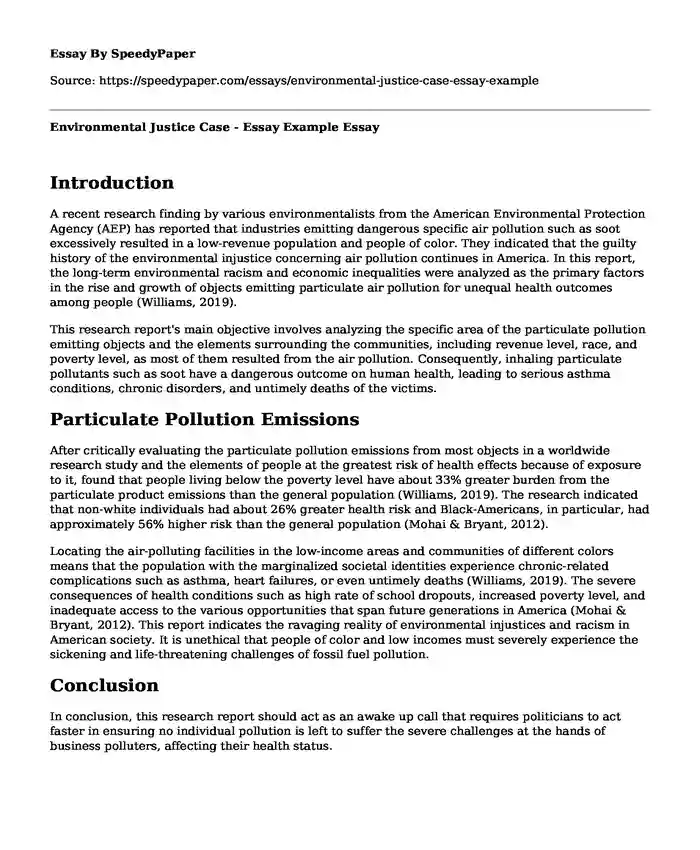Introduction
A recent research finding by various environmentalists from the American Environmental Protection Agency (AEP) has reported that industries emitting dangerous specific air pollution such as soot excessively resulted in a low-revenue population and people of color. They indicated that the guilty history of the environmental injustice concerning air pollution continues in America. In this report, the long-term environmental racism and economic inequalities were analyzed as the primary factors in the rise and growth of objects emitting particulate air pollution for unequal health outcomes among people (Williams, 2019).
This research report's main objective involves analyzing the specific area of the particulate pollution emitting objects and the elements surrounding the communities, including revenue level, race, and poverty level, as most of them resulted from the air pollution. Consequently, inhaling particulate pollutants such as soot have a dangerous outcome on human health, leading to serious asthma conditions, chronic disorders, and untimely deaths of the victims.
Particulate Pollution Emissions
After critically evaluating the particulate pollution emissions from most objects in a worldwide research study and the elements of people at the greatest risk of health effects because of exposure to it, found that people living below the poverty level have about 33% greater burden from the particulate product emissions than the general population (Williams, 2019). The research indicated that non-white individuals had about 26% greater health risk and Black-Americans, in particular, had approximately 56% higher risk than the general population (Mohai & Bryant, 2012).
Locating the air-polluting facilities in the low-income areas and communities of different colors means that the population with the marginalized societal identities experience chronic-related complications such as asthma, heart failures, or even untimely deaths (Williams, 2019). The severe consequences of health conditions such as high rate of school dropouts, increased poverty level, and inadequate access to the various opportunities that span future generations in America (Mohai & Bryant, 2012). This report indicates the ravaging reality of environmental injustices and racism in American society. It is unethical that people of color and low incomes must severely experience the sickening and life-threatening challenges of fossil fuel pollution.
Conclusion
In conclusion, this research report should act as an awake up call that requires politicians to act faster in ensuring no individual pollution is left to suffer the severe challenges at the hands of business polluters, affecting their health status.
References
Mohai, P., & Bryant, B. (2012). Environmental injustice: weighing race and class as factors in the distribution of environmental hazards. U. Colo. L. Rev., 63, 921.
Williams, R. W. (2019). Environmental injustice in America and its politics of scale. Political Geography, 18(1), 49-73.
Cite this page
Environmental Justice Case - Essay Example. (2023, Dec 25). Retrieved from https://speedypaper.net/essays/environmental-justice-case-essay-example
Request Removal
If you are the original author of this essay and no longer wish to have it published on the SpeedyPaper website, please click below to request its removal:
- Trials and Verdicts - Free Essay in Criminal Justice
- Volkswagen's Emission Scandal, Free Essay for Students
- Free Essay: Environmental Problems in the African Continent and Ways to Address the Problems
- Free Essay Example: Future Development or Implementation of Green Buildings
- Compare and Contrast Essay on Cameroon and Stokeling Cases
- Free Essay. Introduction to Victimology
- Essay Sample Police Brutality and Discriminations Against Women and LGBT People
Popular categories





